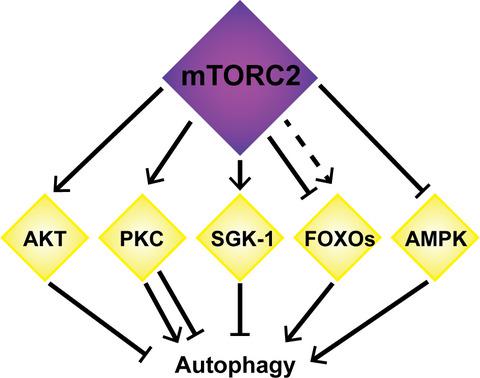当前位置:
X-MOL 学术
›
Aging Cell
›
论文详情
Our official English website, www.x-mol.net, welcomes your feedback! (Note: you will need to create a separate account there.)
mTORC2: The other mTOR in autophagy regulation
Aging Cell ( IF 7.8 ) Pub Date : 2021-07-12 , DOI: 10.1111/acel.13431 Josué Ballesteros-Álvarez 1 , Julie K Andersen 1
Aging Cell ( IF 7.8 ) Pub Date : 2021-07-12 , DOI: 10.1111/acel.13431 Josué Ballesteros-Álvarez 1 , Julie K Andersen 1
Affiliation

|
The mechanistic target of rapamycin (mTOR) has gathered significant attention as a ubiquitously expressed multimeric kinase with key implications for cell growth, proliferation, and survival. This kinase forms the central core of two distinct complexes, mTORC1 and mTORC2, which share the ability of integrating environmental, nutritional, and hormonal cues but which regulate separate molecular pathways that result in different cellular responses. Particularly, mTORC1 has been described as a major negative regulator of endosomal biogenesis and autophagy, a catabolic process that degrades intracellular components and organelles within the lysosomes and is thought to play a key role in human health and disease. In contrast, the role of mTORC2 in the regulation of autophagy has been considerably less studied despite mounting evidence this complex may regulate autophagy in a different and perhaps complementary manner to that of mTORC1. Genetic ablation of unique subunits is currently being utilized to study the differential effects of the two mTOR complexes. RICTOR is the best-described subunit specific to mTORC2 and as such has become a useful tool for investigating the specific actions of this complex. The development of complex-specific inhibitors for mTORC2 is also an area of intense interest. Studies to date have demonstrated that mTORC1/2 complexes each signal to a variety of exclusive downstream molecules with distinct biological roles. Pinpointing the particular effects of these downstream effectors is crucial toward the development of novel therapies aimed at accurately modulating autophagy in the context of human aging and disease.
中文翻译:

mTORC2:自噬调节中的另一个 mTOR
雷帕霉素 (mTOR) 的机制靶标作为一种普遍表达的多聚体激酶,对细胞生长、增殖和存活具有重要意义,因此引起了广泛关注。这种激酶形成了两个不同复合物 mTORC1 和 mTORC2 的核心,它们共享整合环境、营养和激素信号的能力,但它们调节导致不同细胞反应的单独分子途径。特别是,mTORC1 已被描述为内体生物发生和自噬的主要负调节因子,自噬是一种降解溶酶体内的细胞内成分和细胞器的分解代谢过程,被认为在人类健康和疾病中起关键作用。相比之下,尽管越来越多的证据表明这种复合物可能以与 mTORC1 不同且可能互补的方式调节自噬,但对 mTORC2 在自噬调节中的作用的研究却相当少。目前正在利用独特亚基的基因消融来研究两种 mTOR 复合物的差异效应。RICTOR 是对 mTORC2 特异性描述最好的亚基,因此已成为研究该复合物具体作用的有用工具。mTORC2 的复合物特异性抑制剂的开发也是一个备受关注的领域。迄今为止的研究表明,mTORC1/2 将每个信号复合到各种具有不同生物学作用的专有下游分子。
更新日期:2021-08-19
中文翻译:

mTORC2:自噬调节中的另一个 mTOR
雷帕霉素 (mTOR) 的机制靶标作为一种普遍表达的多聚体激酶,对细胞生长、增殖和存活具有重要意义,因此引起了广泛关注。这种激酶形成了两个不同复合物 mTORC1 和 mTORC2 的核心,它们共享整合环境、营养和激素信号的能力,但它们调节导致不同细胞反应的单独分子途径。特别是,mTORC1 已被描述为内体生物发生和自噬的主要负调节因子,自噬是一种降解溶酶体内的细胞内成分和细胞器的分解代谢过程,被认为在人类健康和疾病中起关键作用。相比之下,尽管越来越多的证据表明这种复合物可能以与 mTORC1 不同且可能互补的方式调节自噬,但对 mTORC2 在自噬调节中的作用的研究却相当少。目前正在利用独特亚基的基因消融来研究两种 mTOR 复合物的差异效应。RICTOR 是对 mTORC2 特异性描述最好的亚基,因此已成为研究该复合物具体作用的有用工具。mTORC2 的复合物特异性抑制剂的开发也是一个备受关注的领域。迄今为止的研究表明,mTORC1/2 将每个信号复合到各种具有不同生物学作用的专有下游分子。



























 京公网安备 11010802027423号
京公网安备 11010802027423号